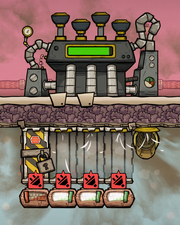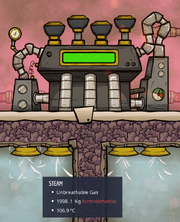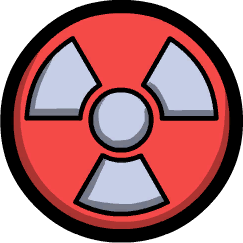 |
This article has not been revised for the current version (U51-600112). It was last updated for U47-562984. It may contain inaccuracies. |
Steam Turbine is the primary device in harvesting Power from Heat, usually magma or Aquatuners, and can do it exceptionally well provided you can keep the temperature of the Steam passing the turbine high.
Steam Turbines are also an incredibly effective heat deletion device capable of removing significant amounts of heat from the environment and turning the heat into power instead; this makes the Steam Turbine useful in many cooling devices.
It requires a Duplicant with Electrical Engineering skill to build.
Requirements[ | ]
The steam below the generator must be at least 125 °C. If the steam below the generator becomes less than 125 °C the Steam Turbine will cease to produce any power.
Additionally, the steam turbine itself must be kept below 100 °C. If its temperature gets higher than 100 °C, the warning message "Turbine too hot" will appear, and the turbine will cease to operate.
Mechanics[ | ]
To use the generator it must have hot steam below its base, a water output and a power connection. Note: not all of the inlets need to be uncovered for full functionality (see below).
While active, every non-blocked inlet will use 0.4 kg of Steam (for a max of 2 kg with 5 inlets) per second. It outputs Water with the same mass as input Steam at a fixed temperature of 95 °C.
Maximum Power Production[ | ]
| Power produced per steam temperature | |
| Power to Heat ratio |
is the produced power in W, is the mass flow rate in kg/s and is the temperature of the steam in Celsius.
The power output depends on the consumption rate and the temperature of the steam. Assuming max steam consumption rate (2 kg/s), power output is 242 watts at 125 °C, capped at 850 watts at 200 °C or higher.
With a lower flow rate, a higher temperature is required for the same heat deletion and power production in accordance with the following table:
| Inlets | Required Temp for Max Power |
Flow Rate (kg/s) |
Heat Deleted (kDTU/s) |
Power Produced (W) |
|---|---|---|---|---|
| 5 | 200 °C | 2 | 877.59 | 850 |
| 4 | 226.25 °C | 1.6 | 877.59 | 850 |
| 3 | 270 °C | 1.2 | 877.59 | 850 |
| 2 | 357.5 °C | 0.8 | 877.59 | 850 |
| 1* | 357.5 °C | 0.4 | 438.8 | 425 |
Note for 1 inlet: A steam turbine can absorb 0.08 kg steam in each tick (0.2 second) from each inlet. But a steam turbine needs more than 0.1 kg Steam to start conversion. As a result, when only one inlet is unblocked, the Turbine works only one tick every two ticks. So the average power generation is limited to 425 W, not 850 W. Therefore, the required temperature difference for max power is also reduced by half.
This does not affect the heat deletion and production. They still delete the heat of 0.4 kg Steam per second, and in turn, produce 10% of that + 4 kDTU themselves.
Thus, to summarize this section:
- If the Steam is below 200 °C, have as many inputs unblocked as possible to maximize power generation through having the Turbine suck in as much as steam as possible.
- If the Steam is above 200 °C, block the inputs to just two to maximize power generation while minimizing steam consumption and heat generation of the Turbine.
Heat Deletion[ | ]
| Heat Removed from Steam | |
| Heat Produced by Turbine |
As long as the steam turbine works (own temperature below 100 °C and steam temperature above 125 °C) it will reduce the input steam in temperature to 95 °C Water. How much heat is deleted in kDTU/s depends on the Specific Heat Capacity of Water (4.179(DTU/g)/°C), the flow rate in kg/s, and the steam's temperature in Celsius.
The heat produced by the steam turbine is 10% of the removed Heat plus 4kDTU operational cost.
| Temperature | Heat Deleted (kDTU/s) |
Heat Transfered to Turbine (kDTU/s) |
Real Heat Deleted (kDTU/s) |
|---|---|---|---|
| 125 °C | 250.74 | 25.07 + 4 = 29.07 | 221.67 |
| 150 °C | 459.69 | 45.97 + 4 = 49.97 | 409.72 |
| 200 °C | 877.59 | 87.76 + 4 = 91.76 | 785.83 |
| 300 °C | 1713.39 | 171.34 + 4 = 175.34 | 1538.05 |
| 400 °C | 2549.19 | 254.92 + 4 = 258.92 | 2290.27 |
| 500 °C | 3384.99 | 338.50 + 4 = 342.50 | 3042.49 |
| 750 °C | 5474.49 | 547.45 + 4 = 551.45 | 4923.04 |
| 1000 °C | 7563.99 | 756.40 + 4 = 760.40 | 6803.59 |
Usage[ | ]
Self-Cooled Steam Turbine[ | ]
A Steam Turbine can be used to cool itself using its own 95 °C exhaust water to maintain a temperature of less than 100 °C, this requires limiting the steam temperature to around 135 °C and power output to around 330 watts. Maximizing the heat transfer between the exhaust water and the Steam Turbine involves snaking radiant pipes behind the Steam Turbine. This works for any material radiant pipe (even lead) if the atmosphere is more than 500 g Hydrogen. Copper/Gold radiant pipes even manage to cool the turbine in an +1500g Oxygen atmosphere. This can be made yet more effective by adding in one or more liquid layers.
A self cooling Steam Turbine produces the most power per unit heat deleted of all setups, and they can be very attractive due to not needing an Aquatuner and the associated plumbing, circuit and automation, while being able to cool up to 292.53 kDTU/s without problems. The drawback to this is that, with their limited steam temperature, you will require more of them to match the heat deletion or power production of comparable ATST setups, and so they are best used when space and materials are less important than efficiency.
Maximum Steam Temperature for sustainable self-cooling[ | ]
There is only limited cooling potential in the exhaust water: raising the temperature of 2000 g/s of water from 95 °C to 100 °C requires 41.79 kDTU/s, substituting this into the equation *Heat produced by turbine* and solving for steam temperature results in a value of 140.2 °C, this is where the heat produced by the Turbine exactly equals the available cooling in the water. The Steam Turbine would generate 365 watts.
While theoretically a self-cooled Steam Turbine could run on 140 °C steam this is an unstable equilibrium, if the Turbine gets too hot the flow of exhaust water halts and it is unable to cool itself, typically stalling until the player intervenes. Furthermore heat exchange between the exhaust water and Steam Turbine is imperfect and there may be heat bleed between the Steam chamber and the Steam Turbine. Due to these factors a practical self-cooled Steam Turbine typically runs on steam temperatures not exceeding 135 °C and generates around 330 watts.
Variable number of inlets at high temperatures[ | ]
To remove as much heat as possible, the steam turbine should not be obstructed, but for power efficiency, as much Heat (kDTU) should be turned into usable Energy (J), or rather, no Heat should be wasted.

When the temperature of the steam rises too high multiple ports can be automatically blocked by doors one at a time. Above 200 °C the first door closes, above 226.25 °C the second, and above 270 °C the third. The fourth door however should not close at 357.5 °C, but rather at 444 °C.
The temperature at which two inlets have the 850 W cap is 357.5 °C, any hotter and all DTU above is wasted, a gradual increase.
Taking only one inlet immediately cuts the used DTU's in half, but for every degree the steam gets hotter it also only wastes half of the DTU until it hits 620 °C where it has its own cap of 425 W.
| Temperature | 1 Inlet | 2 Inlets | ||||
|---|---|---|---|---|---|---|
| Heat deleted | Power produced | Heat wasted | Heat deleted | Power produced | Heat wasted | |
| 357 °C | 437.96 kDTU | 212.19 W | 218.98 kDTU | 875.92 kDTU | 848.76 W | 0.00 kDTU |
| 358 °C | 439.63 kDTU | 213.00 W | 219.82 kDTU | 879.26 kDTU | 850.00 W | 2.07 kDTU |
| 359 °C | 441.30 kDTU | 213.81 W | 220.65 kDTU | 882.60 kDTU | 850.00 W | 5.41 kDTU |
| 443°C | 581.72 kDTU | 281.84 W | 290.86 kDTU | 1163.43 kDTU | 850.00 W | 286.24 kDTU |
| 444°C | 583.39 kDTU | 282.65 W | 291.69 kDTU | 1166.78 kDTU | 850.00 W | 289.58 kDTU |
| 445°C | 585.06 kDTU | 283.46 W | 292.53 kDTU | 1170.12 kDTU | 850.00 W | 292.93 kDTU |
| 446°C | 586.73 kDTU | 284.27 W | 293.37 kDTU | 1173.46 kDTU | 850.00 W | 296.27 kDTU |
| 498 °C | 673.65 kDTU | 326.39 W | 336.83 kDTU | 1347.31 kDTU | 850.00 W | 470.12 kDTU |
| 499 °C | 675.33 kDTU | 327.20 W | 337.66 kDTU | 1350.65 kDTU | 850.00 W | 473.46 kDTU |
| 500 °C | 677.00 kDTU | 328.01 W | 338.50 kDTU | 1354.00 kDTU | 850.00 W | 476.80 kDTU |
The exact tipping point is 444.84°C / 832.71 °F / 717.99 K.
Synergy with Thermo Aquatuners[ | ]
Using Water or Polluted Water as Coolant[ | ]
At 200°C two steam turbines can delete 1,755,180 DTU/s, and three Thermo Aquatuners using Water or Polluted Water as coolant produce 1,755,180 DTU/s. This means that two steam turbines to three Thermo Aquatuners is an ideal ratio for deleting heat with the steam turbine when using Water or Polluted Water as the coolant.
Watts of power used:
Heat (DTU/s) deleted per spent watt:
Using Super Coolant as Coolant[ | ]
At 200°C three steam turbines can delete 2,632,770 DTU/s (2,357,490 DTU/s real deletion), and two Thermo Aquatuners using Super Coolant as coolant produce 2,363,200 DTU/s. This means that three steam turbines to two Thermo Aquatuners is a pretty good ratio for deleting heat with the steam turbine when using Super Coolant as the coolant.
Watts of power used:
Heat (DTU/s) deleted per spent watt:
Comparing Power Efficiency of Coolants[ | ]
Using Super Coolant is approximately 23 times more efficient than using Water or Polluted Water as coolant in a Steam Turbine/Thermo Aquatuner combo:
Trivia[ | ]
Reintroducing exhaust water[ | ]
Will cooling the steam with output water give less energy? No, steam turbines yield their power proportional to the amount of heat they delete.
Experiment:
- First, let's assume we have 10 kg Steam at 200 °C, for 5 seconds it will provide 850 W → a total of 8,358 MDTU deleted for 4250 J.
- Then, let's assume the same 10 kg of Steam at 200 °C but add the 95 °C Water back in instantaneously and lets assume the Steam Turbine could suck up water 95 °C hot. For the first second we get 850 W. The second second the steam will be 179 °C for 680 W, the third second 162.2°C for 544 W. On an infinite timescale the water will have reached 95 °C a total of 8,358 MDTU deleted for 4250 J.
Of course a steam turbine will stop at 125 °C, but the heat will remain to be harnessed later.
As a matter of fact the opposite holds true since the more important limit is the 200 °C maximum temperature, or rather the 850 W power cap. If we run the same thought experiment as before, 10 kg of Steam at 300 °C will still run for 5 seconds at 850 W and produce 4250 J of energy... however, the cooled Steam can run for 9 seconds at ever decreasing power (see table below), producing about 5684.69 J while doing so.
| seconds passed | Steam temperature |
Temperature difference |
Power produced |
|---|---|---|---|
| 0 | 300.00 °C | 205.00 | 850.00 W |
| 1 | 259.00 °C | 164.00 | 850.00 W |
| 2 | 226.20 °C | 131.20 | 850.00 W |
| 3 | 199.96 °C | 104.96 | 849.68 W |
| 4 | 178.97 °C | 83.97 | 679.74 W |
| 5 | 162.17 °C | 67.17 | 543.79 W |
| 6 | 148.74 °C | 53.74 | 435.03 W |
| 7 | 137.99 °C | 42.99 | 348.03 W |
| 8 | 129.39 °C | 34.39 | 278.42 W |
| 9 | 122.51 °C | temp too low | |
Steam from multiple rooms[ | ]

For the steam turbine to function only 1 port requires 125 °C. Therefore it is possible to create setup where a steam turbine accepts steam from 2 steam rooms where the temperature of one steam room is at 100 °C and the other above 125 °C. This effectively allows you to cool a room to 100 °C.
Cool and Hot Steam Vents[ | ]
This means with one steam room above 125 °C, the steam from a Cool Steam Vent can be sucked up.
It also means, it can take in steam that is much hotter. One port above 500 °C Steam (0.4 kg/s) from a Steam Vent on one side, and three ports above 135 °C Steam (1.2 kg/s) are effectively 1.6 kg/s of 226.25 °C Steam and produce 850 W.
Other tips[ | ]
- Like most generators it will continue to run, consuming its power source, unless turned off manually or by an automation connection.
- It can often be useful to allow the Steam Turbine to simply waste excess power, if it is primarily being used to delete heat.
- Steam Turbines cannot add to the packets from their output port, so each one should have a dedicated uncloggable pipe segment.
- A metal refinery with a coolant of petroleum, crude oil, or super coolant combined with a steam turbine actually generates excess power when refining iron or steel due to the large amounts of heat generated by the refinery. This is further improved with the operating duplicant's Machinery attribute, since the refinery draws its 1200 W of power for less than the full 40 s/batch.
- An Aquatuner cooling Super Coolant will run energy neutral when combined with a steam turbine that has engie's tune-up. Even better, a single aquatuner/turbine setup with all 5 input ports open will not reach thermal equilibrium until ~236 °C steam temperature, meaning the setup requires no automation. With dupe's time for engie's tune-up and buffered by a power grid, this setup can provide energy-free cooling. Care must be taken not to deplete the heat in the cooling target, otherwise the setup will start drawing power.
- Steam Turbines exchange heat with their foundation tiles, and as such can be cooled with a heat-conductive foundation tile that's not in contact with Steam. Considering how high those tiles' Thermal Conductivity is, one tile can be enough to cool a Turbine when using active cooling.
History[ | ]
- OC-252151: Introduced.
- OC-252656: Steam turbine now works on a pressure differential and no longer requires water cooling.
- QLM3-326232: Steam turbine reworked.
- RP-379337: Steam turbines correctly obtain boost from Engie's Tune-up.
- U47-561558: Steam Turbine shows obstructed tiles for steam intake before placing it.
Reference[ | ]





























